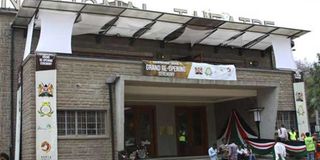Breaking News: KDF chopper crash kills five
Premier platform for artistic performances

The Kenya National Theatre on Harry Thuku Road Nairobi. PHOTO | FILE | NATION MEDIA GROUP
What you need to know:
Venue has provided an avenue for social commentary through productions since its inception.
The building was completed in 1951, and in March, the Kenya Cultural Centre Act (Cap 218 of 1951) was enacted, incorporating the theatre.
Its functions were listed as a venue for the performance and exhibition of art and crafts, as well as for holding discussions of literary and artistic importance.
One cannot discuss the performing arts in Kenya without mentioning the Kenyan Cultural Centre, which houses the Kenya National Theatre. The theatre’s history draws parallels between artistic expression and political development. This is from the time the building was used as the main venue for the use of drama as social commentary, in effect from its inception in the colonial era, to present-day performances by Kenyans in local languages, for which it has become famous.
COLONIAL CHARTER
The idea of a theatre in the country was broached in 1947 by a Mr Rost, a representative of the British Council.
This was after Europeans and Asians approached the colonial government for a place where they could hold artistic performances and other events.
In 1949, the idea was formalised through a colonial charter and the government allocated a plot of land on Harry Thuku Road, opposite the Norfolk Hotel, and a short distance from the Central Police Station.
Its location was strategic, since it would ensure that Africans were kept far away. This was because the effects the Mau Mau rebellion had started being felt in Nairobi. The settlers needed to feel safe, and the theatre’s proximity to the police station offered the needed security.
The building was completed in 1951, and in March, the Kenya Cultural Centre Act (Cap 218 of 1951) was enacted, incorporating the theatre. Its functions were listed as a venue for the performance and exhibition of art and crafts, as well as for holding discussions of literary and artistic importance.
It opened its doors in 1952, in a Whites-only event, officiated by the governor, Sir Evelyn Baring.
ORCHESTRA PIT
At the time, the auditorium could seat 450 people, had a curtained stage, an orchestra pit in the basement, a balcony, and a bar and restaurant on first floor.
In its early days, many Western plays and musicals were staged in it, purely for entertainment. The Dark Lady of Sonnets, a short comedy by George Bernard Shaw, was one of the first productions to be staged there.
The theatre was then viewed as a symbol of oppression. When the State of Emergency was declared in October 1952 due to intensified Mau Mau activity, it became an entertainment spot for the British soldiers commissioned to suppress the Mau Mau uprising.
Ironically, this period saw the early beginnings of comedy in Kenya at the theatre, with the first national comedian, Kipanga Athumani, performing there in July 1955. The act, in which Kipanga caricatured a retired Mau Mau leader fighting in the Aberdares, saw him referred to as “The African comedian who ridicules Mau Mau” by The Birmingham Post.
The entry fee was Sh2. Kipanga became a household name during the emergency, since he would tour the detention camps to entertain the inmates.
INDIGENOUS PLAY
In 1959, The Kenya Schools Drama Festival, modelled on the British Drama Festival, was launched as a private event. It held its national finals held there.
The British Council ran the event, and certain all-White schools were selected to participate. Most of the productions were selected by the expatriate teachers, and tended to be Shakespearean.
Kenya’s Ministry of Education took over the event in 1969. In 1971, the production, Olkirkenyi, by Olekejuado Secondary School, became the first indigenous play to win the festival.
In 1968, Mr Seth Adagala was appointed the first indigenous director of the Kenya National Theatre. It was he who mooted the idea of having a theatre school to teach play production, stage management, acting and script writing, among other aspects of the theatre production. He hoped that it would motivate Africans to use drama as a tool for integration in postcolonial Kenya.
Notable African productions thereafter included Ngaahika Ndeenda (I Will Marry When I Want), the controversial play by Ngugi wa Thiong’o and Ngugi wa Mirii, which saw them locked up without charges.
SCATHING ATTACK
The play was subsequently banned for its scathing attack on the legacies of colonialism and the struggles of ordinary citizens in post-colonial Kenya.
Betrayal in The City by Francis Imbuga was staged at the theatre n 1976.
The theatre was closed for a while but reopened in September 2015. The renovations, sponsored by East African Breweries Limited, turned it into a state-of-the-art facility, hosting artists from around the world as a cultural exchange platform.
Besides the theatre, spaces such as the Cheche Gallery of Visual Arts, Ukumbi Mdogo, the Mugumo Courtyard, dance studio and Igiza Bar and Restaurant are always buzzing with activity, with artists convening here for performances and rehearsals every day. Initiatives such as Poetry After Lunch offer networking opportunities to visiting artists.
The theatre offers a platform for social commentary in an entertaining way.
Is there a site you want us to feature? Write an e-mail to mailb [email protected]




